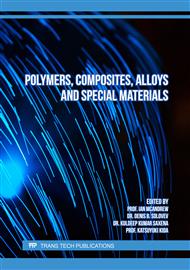p.3
p.9
p.17
p.23
p.29
p.35
p.43
p.55
Effect of Silica/M-BNT/BNT Ternary Filler Loading on the Curing Properties of Natural Rubber Vulcanizates
Abstract:
The goal of this study was to investigate the effect of varied proportions of silica/M-BNT/BNT on the curing properties of natural rubber (NR) composites. Thirteen ternary-filled NR composites and a control sample were prepared in this study based on a third degree – simplex lattice mixture design of experiment. It was observed that high loading of silica has a retarding effect on vulcanization rate due to the presence of silanol groups on its surface. Replacement of silica with BNT led to a big reduction in scorch time and increase in vulcanization rate due to the presence of metallic oxides acting as co-activators. The addition of the organoclay M-BNT to silica and BNT resulted to shorter scorch time, an increase in vulcanization rate, and a decrease in minimum and maximum torques improving the processability of the rubber composite. The kinetic model was able to demonstrate the vulcanization behavior of the rubber composites as supported by the very high coefficient of determination (R2) values for all samples. The generated contour plots for maximum torque (MH), minimum torque (ML), scorch time (tS1), cure rate index (CRI), induction time (ti) and rate constant (k1) were able to display the trends observed in the experimental values.
Info:
Periodical:
Pages:
17-22
Citation:
Online since:
April 2023
Authors:
Keywords:
Price:
Сopyright:
© 2023 Trans Tech Publications Ltd. All Rights Reserved
Share:
Citation:



